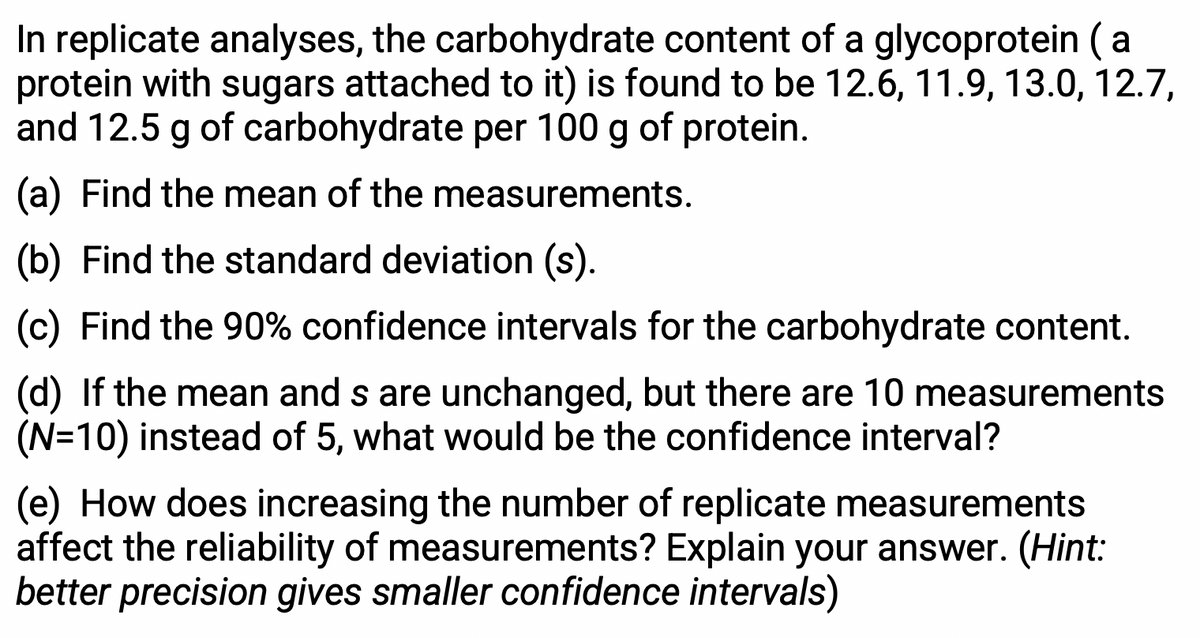In replicate analyses, the carbohydrate content of a glycoprotein ( a protein with sugars attached to it) is found to be 12.6, 11.9, 13.0, 12.7, and 12.5 g of carbohydrate per 100 g of protein. (a) Find the mean of the measurements. (b) Find the standard deviation (s). (c) Find the 90% confidence intervals for the carbohydrate content.
In replicate analyses, the carbohydrate content of a glycoprotein ( a protein with sugars attached to it) is found to be 12.6, 11.9, 13.0, 12.7, and 12.5 g of carbohydrate per 100 g of protein. (a) Find the mean of the measurements. (b) Find the standard deviation (s). (c) Find the 90% confidence intervals for the carbohydrate content.
Chapter4: Least-squares And Calibration Methods
Section: Chapter Questions
Problem 4P
Related questions
Question

Transcribed Image Text:In replicate analyses, the carbohydrate content of a glycoprotein (a
protein with sugars attached to it) is found to be 12.6, 11.9, 13.0, 12.7,
and 12.5 g of carbohydrate per 100 g of protein.
(a) Find the mean of the measurements.
(b) Find the standard deviation (s).
(c) Find the 90% confidence intervals for the carbohydrate content.
(d) If the mean and s are unchanged, but there are 10 measurements
(N=10) instead of 5, what would be the confidence interval?
(e) How does increasing the number of replicate measurements
affect the reliability of measurements? Explain your answer. (Hint:
better precision gives smaller confidence intervals)
Expert Solution
This question has been solved!
Explore an expertly crafted, step-by-step solution for a thorough understanding of key concepts.
Step by step
Solved in 5 steps with 5 images

Follow-up Questions
Read through expert solutions to related follow-up questions below.
Follow-up Question

Transcribed Image Text:(d) If the mean and s are unchanged, but there are 10 measurements
(N=10) instead of 5, what would be the confidence interval?
(e) How does increasing the number of replicate measurements
affect the reliability of measurements? Explain your answer. (Hint:
better precision gives smaller confidence intervals)
Solution
Knowledge Booster
Learn more about
Need a deep-dive on the concept behind this application? Look no further. Learn more about this topic, chemistry and related others by exploring similar questions and additional content below.Recommended textbooks for you


Principles of Modern Chemistry
Chemistry
ISBN:
9781305079113
Author:
David W. Oxtoby, H. Pat Gillis, Laurie J. Butler
Publisher:
Cengage Learning

Principles of Instrumental Analysis
Chemistry
ISBN:
9781305577213
Author:
Douglas A. Skoog, F. James Holler, Stanley R. Crouch
Publisher:
Cengage Learning


Principles of Modern Chemistry
Chemistry
ISBN:
9781305079113
Author:
David W. Oxtoby, H. Pat Gillis, Laurie J. Butler
Publisher:
Cengage Learning

Principles of Instrumental Analysis
Chemistry
ISBN:
9781305577213
Author:
Douglas A. Skoog, F. James Holler, Stanley R. Crouch
Publisher:
Cengage Learning

Chemistry & Chemical Reactivity
Chemistry
ISBN:
9781133949640
Author:
John C. Kotz, Paul M. Treichel, John Townsend, David Treichel
Publisher:
Cengage Learning
